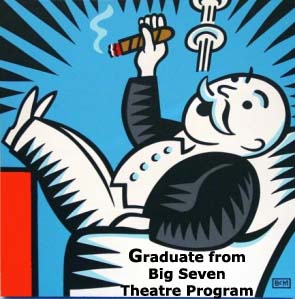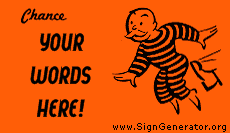How to Play the Diversity Card
The theatrosphere’s talk on diversity has gone from bad to worse. The three shills in the house, linking to each other’s blog posts to keep the thread undead, have been Isaac, 99 seats, and Scott. This comment by KL at Isaac’s correctly summarizes why everyone is jumping off this ship to nowhere.
It’s not much of a conversation.
It’s mostly one side arguing a principle (we need more diversity!) without really offering any facts. Instead, unsupported suppositions, misleading correlations and inappropriate parallels are offered in support of a hypothetical ideas of what’s wrong. Underneath it all is a concept that “good” has an objective set of criteria… a concept that is also unexamined with any depth and that there are plenty of plays that meet these criteria but are overlooked because the authors are from the wrong class. These thoughts are then followed by some strange and rather ridiculous ideas about how to fix it (a lottery, for instance).
Meanwhile, others make points based on anecdotes, which – while always suspect for drawing larger conclusions – are at least based on direct experience. However, when this group points out what they’ve actually seen and heard with their own eyes and ears they are labeled as being privileged and blind. So when they counter they appear to become increasing shrill…
The whole thing is real turn-off.
KL’s comment addresses where the conversation has evolved but it should probably be noted that the thread began with everyone commenting on a study that no one has yet read. As a result, no one mentions the idiosyncratic and convoluted manner in which the pool of playwrights at the basis of this study was created.
We surveyed a group of randomly selected TCG members as well as a select group of theatres that regularly produce new plays. A total of 94 theatre surveys were used and of those about 75% were from the first group and 25% from the second. Additionally, we identified playwrights from a variety of “universes” including university alumni, members of writers’ collectives and labs, fellowship and grant recipients, new work festival and competition submissions, commissions, playwrights whose scripts have been produced, and prize and award recipients. In total, 340 playwright surveys were sent and 250 usable surveys were returned.
Obviously there will be some “universes” of playwrights that are not represented in the supposed quantitative research that went into this study.

Why I am mostly absent from these “diversity discussions” is that they are limited to beating the same nail with the same hammer over and over again. Scott ostensibly broadens the discussion by introducing the notion of class diversity but that becomes easily reducible both by him and others into the White Male privilege. The discussion can now end, or we can beat that same old gender/race nail a few more times with the culture’s big hammer of political correctness. Law professor Anthony T. Kronman frames the problem concisely in this essay adapted from his book Education’s End: Why Our Colleges and Universities Have Given Up on the Meaning of Life.
Whatever fails to accord with the values of political liberalism fits uncomfortably within the range of possibilities that the prevailing conception of diversity permits students to acknowledge as serious contenders in the search for an answer to the first-personal question of what living is for. The political philosophies of Plato and Aristotle, with their easy acceptance of the natural inequality of humans, offend these values at every turn. So, too, does the theological tradition that runs from Augustine to Calvin, with its insistence on church authority and its doctrines of sin and grace. And much of poetry is motivated by an anti-democratic love of beauty and power.
All of these ideas and experiences are suspect from the standpoint of liberal values. None represents the “right” kind of diversity. None is suitable as a basis for political life, and hence — here is the crucial step — none is suitable (respectable, acceptable, honorable) as a basis for personal life either. None, in the end, can perform any useful function other than as an illustration of the confused and intolerant views of those who had the misfortune to be born before the dawning of the light.
Today’s idea of diversity is so limited that one might with justification call it a sham diversity, whose real goal is the promotion of a moral and spiritual uniformity instead. It has no room for the soldier who values honor above equality, the poet who believes that beauty is more important than justice, or the thinker who regards with disinterest or contempt the concerns of political life. The identification of diversity with race and gender has thus brought us back full circle to the moral uniformity with which American higher education began, nearly four centuries ago.
UPDATE: I received the following email from TDF this evening: “Thank you for your interest in “Outrageous Fortune, the Life and Times of the New American Play. The book is now available for purchase on TDF’s website.”

2 thoughts on “How to Play the Diversity Card”
Great post. And worthy of consideration by all.
Good heavens man, beauty IS justice.
Comments are closed.